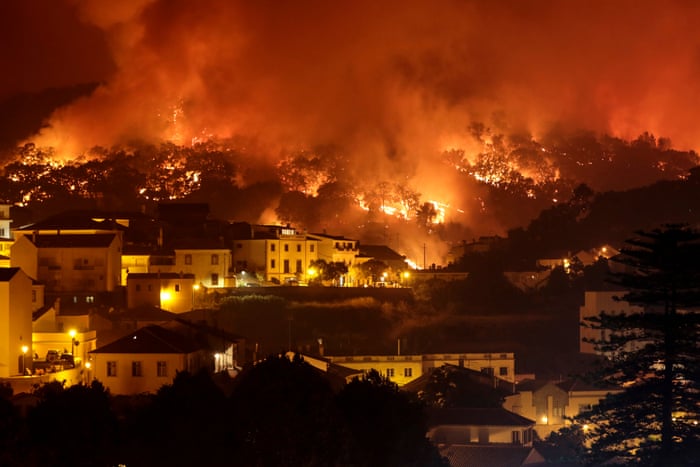Buildings and communities can be built in such a way that fires sweep through them—or better still, around them—leaving them more-or-less intact.
建筑和社區建可以以這樣一種方式建在,即火災會席卷,或者更好的是,將它們包圍,使它們或多或少保持完整。
Infrastructure can be made more resilient. And forests themselves can be managed to reduce the risk of catastrophic blazes.
可以使基礎設施更具恢復力。森林本身可以減少災難性火災的風險。
Start with the buildings. Most buildings burn not when the flaming front of a fire reaches them,
先從建筑開始。大多數建筑物會在大火的火焰觸及建筑物,
but when embers (also called "firebrands") thrown off by distant fires land on them.
而不是在遠處的大火拋出的余燼(也被稱為“火種”)落在它們身上時燃燒。
A 2010 paper tracked how a 1991 fire in Oakland Hills burned steadily in a cluster of houses before embers were lifted by strong winds,
2010年的一篇論文追蹤了1991年奧克蘭丘的一場火災如何在一群房屋中持續燃燒,直到余燼被強風吹起,
landing on other houses hundreds of metres away and igniting more than a dozen new "spot fires".
落在幾百米外的其他房屋上,并引發了十幾起新的“二次火災”。
Estimates of the share of buildings lost to firebrands vary, but all are large—between 60% and 90%.
對火災造成的建筑物損失的估計各不相同,但損失都很大——在60%到90%之間。
Clever design can help make buildings resistant to fires that spread in this way.
聰明的設計可以幫助建筑物抵抗以這種方式蔓延的火災。

Materials such as concrete, adobe or stucco are a better bet than cladding walls in flammable wood.
像混凝土、土坯或灰泥這樣的材料是比用易燃木材做覆蓋板墻更好的選擇。
Some composite panels promise to hold back the flames for two hours or more. Gaps under roofs can be blocked up, to stop embers drifting in.
一些復合材料面板承諾可以阻止火焰燃燒兩個小時或更長時間。房頂下的空隙可以被堵住,以阻止余燼飄進來。
Vents can be covered with mesh, or eliminated entirely. Heat-resistant windows, which are less likely to break, help keep firebrands out.
通風口可以用網絲覆蓋,或者完全不要通風口。不易碎的隔熱窗戶有助于將火源擋在外面。
Experts recommend a five-foot "non-combustible zone" around the base of homes.
專家建議房屋底部周圍設置一個5英尺的“不易燃區”。
Neighbourhoods can be toughened up, too. In a report published in April,
鄰里關系也可以得到增強。在四月出版的一篇報道中,
Dr Moritz and his colleague Van Bustic at the University of California in Berkeley describe how entire communities can be planned to resist fires.
Moritz博士和加州大學伯克利分校的同事描述了整個社區如何計劃抵御火災。
Building near water is one tactic. But moats are not the only defence.
建在水邊是一種策略。但護城河并不是唯一的防御手段。
Open agricultural lands—including the vineyards common in the Napa Valley— can offer a useful buffer, too.
開放農業用地——包括在納帕谷常見的葡萄園——也能提供有效的緩沖。
Even golf courses can serve as firebreaks. Rather than lining the greens with homes, Dr Moritz suggests doing the opposite, and putting houses in the middle.
即便是高爾夫球場也能作為防火帶。與其把綠色區域與房屋排在一排,Moritz博士建議不如反過來,并把房屋排在中間。
Burying electricity lines can help avoid blackouts, as well as subsequent costly rebuilding.
埋線可以幫助避免停電,以及后續昂貴的重建費用。
It can also prevent power lines themselves sparking fires.
還能防止電線本身引發火災。
That is a persistent problem in California, and one which has cost Pacific Gas & Electric, a utility, billions in settlements.
這在加州是一個長期存在的問題,已經讓太平洋煤氣與電力公司花費了數十億美元的和解費用。
Australia, which also suffers from wildfires, has experimented with bunkers specially designed to withstand flames for an hour or more—
同樣遭受野火襲擊的澳大利亞已經試驗了一種特別設計的掩體,可以承受一個小時或更長時間的火焰——
long enough for a flaming front to move through. These offer a last-resort option for trapped residents.
足以讓火頭通過。這為被困居民提供了最后的選擇。
譯文由可可原創,僅供學習交流使用,未經許可請勿轉載。












